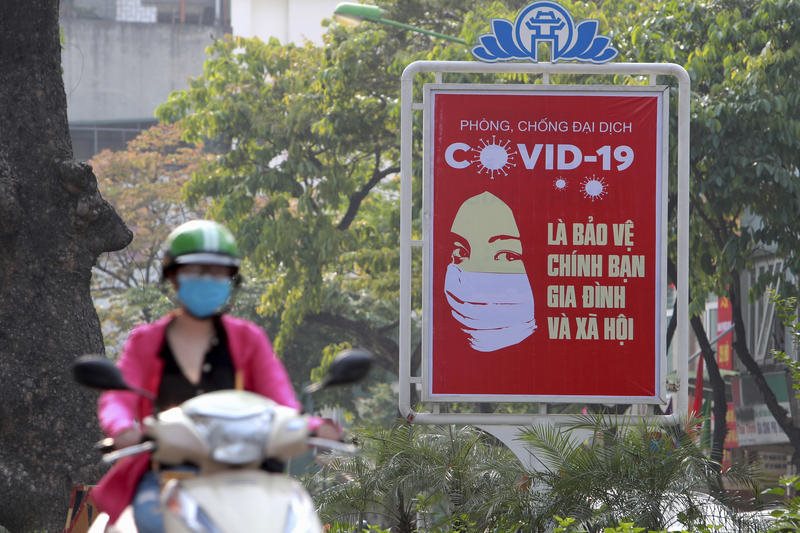How did Vietnam do it? Public Health and Fiscal Measures Beat Back COVID-19
 Credit AP PHOTO/HAU DINH)
Credit AP PHOTO/HAU DINH)
As of April 29, Vietnam has recorded zero coronavirus deaths for 270 reported cases. Vietnam shares a border with China, the initial viral epicenter of the pandemic, yet interestingly the virus did not spread from there.
Like Burkina Faso (see earlier blog) it was able to trace its patient zero, a fashion influencer who returned to Hanoi on March 2 after visiting London, Milan and Paris.
Vietnam can boast to have now one of the lowest mortality rates in the world. This was made possible by an aggressive 3-pronged approach of containment, testing and communication that is giving the healthcare system time to treat each patient, and in so doing, keeping the number of COVID-19 deaths at zero. Furthermore, various fiscal measures taken by the government alleviate economic pressure faced by individuals and households, particularly the vulnerable. These measures were shared across the national territory and involved both provincial and local governments.
Containment Measures
As of April 22, approximately 67,000 people were quarantined in centralized facilities or self-locations.
The government has adopted gradually strict containment measures since late January, including social distancing, travel bans on all foreign travelers (except for diplomatic, official and other extraordinary purposes), screening at ports of entry, a 14-day self-isolation requirement for all international arrivals, school closures, and public event cancelations.
Other measures include strictly enforcing wearing of masks at public venues from March 16 and shutting down non-essential services nationwide.
The government announced the National Epidemic status on April 1 and imposed social isolation on a national scale from April 1-22 to encourage people to stay home and strictly minimize domestic travel.
The nationwide social isolation was removed from April 23, except for few districts in Hanoi, Ha Giang, and Bac Ninh provinces. Schools are resuming and 30 percent of public transportation is resumed.
Testing
Starting in February, anyone arriving at an airport in a major Vietnamese city has to go through compulsory body temperature screening and fill in a health self-declaration, stating their contact details and travel and health history. These measures are now mandatory for everyone entering major cities and some provinces by land too, and for everyone entering a government building or hospital.
Intensive testing across the country has been put in place. Testing stations are set up across cities, which all citizens can attend. Groups of people who live near confirmed cases – sometimes an entire street or village – are swiftly tested and placed in lockdown.
Testing kits are all being manufactured in Vietnam for less than US$25. These affordable test kits have helped the government realize their intensive testing strategy.
Starting in February, anyone arriving at an airport in a major Vietnamese city has to go through compulsory body temperature screening and fill in a health self-declaration, stating their contact details and travel and health history. These measures are now mandatory for everyone entering major cities and some provinces by land too, and for everyone entering a government building or hospital.
Intensive testing across the country has been put in place. Testing stations are set up across cities, which all citizens can attend. Groups of people who live near confirmed cases – sometimes an entire street or village – are swiftly tested and placed in lockdown.
Testing kits are all being manufactured in Vietnam for less than US$25. These affordable test kits have helped the government realize their intensive testing strategy.
Communication
The government implemented an effective communication strategy disseminated from central government officials to provincial governments to communes .
Vietnam is organized with a three-tier local government system: provinces, districts and communes. Rural local governments include 8,978 communes, 546 rural districts and 58 provinces. Urban local governments include 1,581 wards and 603 commune-level towns (townships), 49 urban districts, 51 district-level towns and 67 provincial cities, as well as five cities (Can Tho, Da Nang, Ha Noi, Hai Phong, Ho Chi Minh City) whose administration is still controlled by the national government.
In this complex tissue of localities, the government uses mobile texts and has partnered with messaging platforms such as Zalo to distribute updates on symptoms and protection measures. Using provincial cities as relays of testing and prevention has benefited Vietnam and shows how important it is to have decision power close to the citizen. COVID-19 crisis has demonstrated the effectiveness of fast local action to slow the spread of the virus and to prepare for the post-crisis recovery.
Fiscal measures
Aside from a plethora of tax reduction measures, the government has implemented cash transfers worth VND 36 trillion (0.5% of GDP, $US 1.5 million) from the state budget to the following affected entities:
the poor and near poor households (VND 250,000/person/month, US$10);
- recipients of social protection programme (additional of VND 500,000/person/month on top of the monthly allowance, US$21);
- workers who temporarily stopped working or have been on unpaid leave (VND 1.8 million/person/month, US$77);
- unemployed workers without unemployment insurance, and self-employed workers (VND 1 million/person/month, US$43);
- households with monthly taxable revenue below VND 100 million/month that temporarily suspended business (VND 1 million/household/month, $US43).
Monthly cash transfers would be provided for no more than 3 months, from April to June. More than 10% of the population is estimated to benefit from this programme.
The government also approved a temporary cut in electricity prices by a maximum of 10% for 3 months to support firms and households.
Additional measures have been implemented to accelerate public investment disbursement, including permitting direct procurement and transforming PPP projects into 100% public investment projects, etc.
Blog entry written by Amadou Sy, amadou.sy@uncdf.org , edited by Nan Zhang, nan.zhang@uncdf.org.